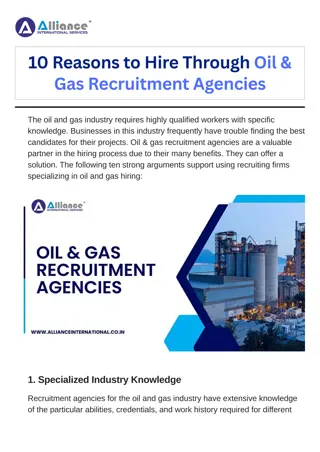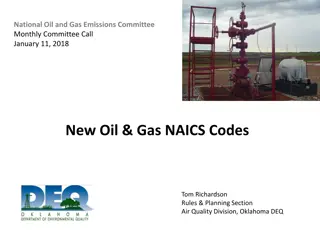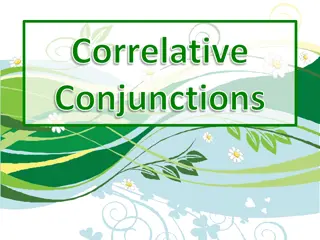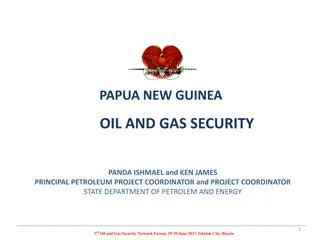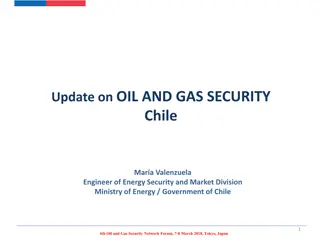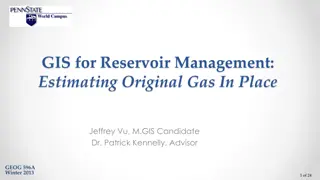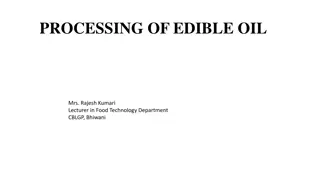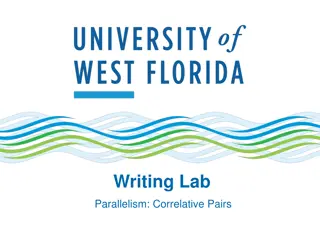Exploring Correlative Rights in Oil and Gas: Past, Present, and Future
Delve into the concept of correlative rights in oil and gas, understanding its individual and common components. Recognize the importance of defining both exclusive and non-exclusive aspects of ownership to navigate complex development issues effectively. Explore the history, current status, and recommended practices related to correlative rights under Arkansas law. Learn from early cases like Hague v. Wheeler, emphasizing the need to protect correlative rights and maintain good neighborhood duties within the oil and gas industry.
Download Presentation

Please find below an Image/Link to download the presentation.
The content on the website is provided AS IS for your information and personal use only. It may not be sold, licensed, or shared on other websites without obtaining consent from the author. Download presentation by click this link. If you encounter any issues during the download, it is possible that the publisher has removed the file from their server.
E N D
Presentation Transcript
Exploring Past, Present, and Future Roles for Correlative Rights David Pierce Washburn University School of Law Topeka, Kansas 1
Correlative Rights Concurrent rights in a common resource. Correlative rights in oil and gas have both individual and common components. Exclusive and non-exclusive components. Property law doctrine generally focuses on the individual and exclusive; boundary lines. Conceptually it is more difficult to define the common and non-exclusive. 2
Correlative Rights Those rights that owners in a connected resource have to protect their individual rights and exercise their common rights. 3
Correlative Rights To properly respond to increasingly complex oil and gas development issues, we must be prepared to fully define the common and non-exclusive aspects of ownership in the oil and gas reservoir. This will require further definition of each owner s correlative development of a correlative rights doctrine to marshal those rights. rights and further 4
Correlative Rights My talk will: Identify the history and current status of correlative rights under Arkansas law. Demonstrate how a failure to consider correlative rights results in the use of ill-suited remedies such as trespass. Introduce you to a recommended reservoir community analysis. 5
The Origins of Correlative Rights Hague v. Wheeler, 27 A. 714 (Pa. 1893). The case best known as a rejection of a correlative rights doctrine is actually an early recognition of the concept. Here, private rights prevail over public rights. Supreme Court elected to protect the correlative rights of the wasting party. 6
The Origins of Correlative Rights The trial judge considered correlative rights limitations recognized under water law and commented on certain duties of good neighborhood that were applicable to the oil and gas reservoir. 7
The Origins of Correlative Rights What then, are the rights of adjoining owners of oil and gas? Are they absolute and independent, or qualified and correlative? The right of each owner is qualified because of the connected nature of the right; each must submit to such limitations as are inevitable to enable each to get his own. 8
The Origins of Correlative Rights The Supreme Court: Owners in a common source of supply (a reservoir ) are subject to two limitations: he must not disregard his obligations to the public, he must not disregard his neighbor s rights. An offer to sell gas to neighbor was the only recognition required under the facts. 9
The Origins of Correlative Rights Ohio Oil Co. v. Indiana, 177U.S. 190 (1900). Protection of correlative rights of private owners relied upon to support state law protecting public rights. Public actions to prevent waste caused by Ohio Oil acceptable when pursued to protect the private property rights (correlative rights) of other owners in the reservoir. 10
The Origins of Correlative Rights Bandini Petroleum Co. v. Superior Court, 284 U.S. 8 (1931). California Oil and Gas Conservation Act enforced to enjoin the unreasonable waste of natural gas. Lower Court: public interest basis in doubt. Supreme Court: statute can be upheld as one regulating the exercise of the correlative rights of the owners; a private property basis. 11
The Origins of Correlative Rights Correlative rights were first addressed by the Arkansas Legislature in the 1920s through broad prohibitions of waste. The prohibited conduct included actions that could impair the ability of other owners in the reservoir to exercise their capture rights. 12
The Origins of Correlative Rights Act 664 of 1923, 2: The term waste . . . shall include (1) escape of natural gas in commercial quantities into the open air; (2) the intentional drowning with water of gas stratum capable of producing gas in commercial quantities; waste; (4) the permitting of any natural-gas well to wastefully burn; and (5) the wasteful utilization of such gas; . . . . (3) underground 13
The Origins of Correlative Rights The other major concern was equal access to marketing outlets. For example: Act 664 of 1923, 4 (restrictions on production to match marketdemand ) and 5 & 6 (pipelines must act as common purchasers and cannot discriminate in taking gas). 14
The Origins of Correlative Rights The conservation acts was to protect the natural gas resource from being destroyed in the process of producing oil. The 1939 Conservation Law included a new focus on oil as well as gas. primary focus of the pre-1939 15
The Origins of Correlative Rights Ratable production continued to be a major concern. The 1939 Act defined waste to include: Abuse of the correlative rights and opportunities of each owner of oil and gas in a common reservoir due to non-uniform, disproportionate, and unratable withdrawals causing undue drainage between tracts of land. 16
The Origins of Correlative Rights This limited definition of correlative rights is carried forward, without change, to the present statutory definition. ARK. CODE ANN. 15-72-102(15)(C) (2009). The same definition is used in the Commission s regulations. ARK. OIL AND GAS COMM N, GEN. RULES AND REGS., RULE A-4: DEFINITIONS, WASTE(3), 18 (Jan. 20, 2014). 17
The Origins of Correlative Rights In the Act s Declaration of policy the Legislature equates coequal or correlative rights of owners of crude oil or natural gas in a common source of supply to produce and use the crude oil or natural gas to compelling ratable production. ARK. CODE ANN. 15-72-101 (2009). 18
The Origins of Correlative Rights The equal opportunity definition of correlative rights is carried through in the statutes requiring drilling units to: [A]fford the owner of each tract . . . the opportunity to recover or receive his or her just and equitable share of the oil and gas in the pool without unnecessary expense and will prevent or minimize reasonably avoidable drainage from each developed unit which is not equalized by counter drainage. ARK. CODE ANN. 15-72-304 (2009). 19
The Origins of Correlative Rights Common law correlative rights in Arkansas? As Thomas Daily has noted: Please remember though, correlative rights are not common law rights; they are one hundred percent statutory. Thomas A. Daily, Lawyering the Fayetteville Shale Play Welcome To My World, 44 ARKANSAS LAWYER 10, 12 (Spring, 2009). 20
The Origins of Correlative Rights Are there commonlaw correlative rights? One commentator Arkansas would likely recognize a limitation on the rule of capture similar to that imposed by the Texas Supreme Court in Elliff v. Texon Drilling Co., 210 S.W.2d 558 (Tex. 1948). Susan Webber Wright, The Arkansas Law of Oil and Gas, 9 U. OF ARK. AT LITTLE ROCK L.J. 223, 234-35 (1987). has suggested that 21
The Origins of Correlative Rights Any act that impairs the ability of other owners to exercise their capture rights would be a violation of their correlative rights. This analysis is supported by the court s observations in Young v. Ethyl Corporation, 521 F.2d 771 (8th Cir. 1975), cert. denied, 439 U.S. 1089 (1979), where it noted the rule of capture would be constrained by the doctrine of correlative rights. 22
The Origins of Correlative Rights However, Young was a brine case. The brinecases demonstrate a reluctance by courts to grant any one party in a reservoir an undue advantage because of the connected nature of the reservoir. 23
The Origins of Correlative Rights If courts give the hold-out a trespass claim, the hold-out receives undue power over the operator desiring to invest in secondary and other enhanced recovery techniques that require use of the reservoir. The trespass remedy does much more than merely protect the owner s land; it effectively impedes use of the entire reservoir. When dealing with a connected reservoir any trespass remedy will have considerable extra- territorial impact. 24
The Origins of Correlative Rights If courts give the operator the benefits of the rule of capture to deal with the hold-out, the operator receives undue power over the hold- out and may elect to simply ignore them. 25
The Origins of Correlative Rights The court in Young opined that if it adopted a capture remedy (which it rejected), the operator would nevertheless be subject to the doctrine of correlative rights. The court, however, limited the doctrine to a duty not to injure the source of supply or to take an undue proportion of the oil and gas from the common pool. 26
The Origins of Correlative Rights The court focused on the undueproportion language suggesting that allowing the rule of capture to operate in this situation would, in any event, violate correlative rights by allowing the operator to take an undue proportion of the brine. 27
The Origins of Correlative Rights The balance between trespass and the rule of capture was ultimately struck in Jameson v. Ethyl Corporation, 609 S.W.2d 346 (Ark. 1980). The court allowed the otherwise trespassing activity to take place so long as such operations are carried out in good faith for the purpose of maximizing recovery from a common pool. 28
The Origins of Correlative Rights However, compensate the owner of the depleted lands for the minerals extracted in excess of natural depletion, if any, at the time of taking and for any special damages which may have been caused to the depleted property. the extracting party must 29
The Origins of Correlative Rights Water and correlative rights. The oil and gas industry shunned water law as a guide for correlative rights analysis because it was also used to allocate water quantity rights. This allocative component ran counter to the rule of capture. However, water law correlative rights has a non- allocative component that offers insight for dealing with intra-reservoir disputes. 30
The Origins of Correlative Rights Harris v. Brooks, 283 S.W.2d 129 (Ark. 1955) (adopting reasonable use theory as applied to surface waters). The use of the stream or water by each proprietor is . . . limited to what is reasonable, having due regard for the rights of others above, below, or on the opposite shore. 31
The Origins of Correlative Rights The rights of the riparian owner are qualified only by the correlative rights of other riparian owners, and by certain rights of the public, and they are to be so exercised as not to injure others in the enjoyment of their rights. 32
The Origins of Correlative Rights Jones v. Oz-Ark-Val Poultry Company, 306 S.W.2d 111 (Ark. 1957) (adopting reasonable use theory as applied to subsurface waters). [T]he right of a landowner to appropriate percolating water in his own land is limited by the corresponding right of his neighbor, and extends only to a reasonable exercise of such right; or, as said by the court, the rights are correlative. 33
The Origins of Correlative Rights Where two or more persons own different tracts of land, underlaid by porous material extending to and communicating with them all, which is saturated with water moving with more or less freedom therein, each has a common and correlative right to the use of this water . . . . 34
The Origins of Correlative Rights Common law correlative rights, as applied to oil and gas law, reamin to be developed in Arkansas. I predict this will occur as courts find it necessary to more completely define aspects of oil and gas ownership that have, to date, not been defined. 35
Previously Undefined Contours of Oil and Gas Ownership Not changing or re-defining rights. Defining rights for the first time. The precise circumstances have not been the focus of prior litigation. Must be sure that all relevant circumstances are considered when declaring ownership and the resulting property rights. 36
Property Law Defines Tort Law Defining ownership as a matter of property law will also define the scope of tort law. The nature of an ownership (property law) will often be determinative when evaluating whether something is a trespass or nuisance (tort law). adjacent owner s 37
The Issues Triggering the Inquiry The specific issue: How should courts respond to a frac fissure that crosses subterranean property lines? The more general issue: How should courts resolve cross-boundary intra-reservoir conflicts? 38
The Key Observation Rights in a reservoir cannot be isolated from the reservoir. It is not possible to set apart ownership in a reservoir from the reservoir. Rights in a reservoir are connected and therefor collective. Each owner has communal rights in the reservoir community. 39
Negative and Positive Rights In the past most of the focus has been on rights and duties that place limitations on what an owner can do within the reservoir: negative rights. The fracing issue, and other intra-reservoir conflicts, require that we explore the positive rights aspects of correlative rights. 40
The Ad Coelum Doctrine The ad coelum doctrine is the abbreviated term used to describe the extent of ownership in land within surface boundaries. Ownership extends above and below the land surface. Much of the law of property depends upon boundary lines drawn upon the surface of land. 41
The Ad Coelum Doctrine This extension of surface boundaries to define subsurface rights operates on the same fence- line mentality used to define surface rights. Oil and gas can move within the reservoir rock structure, and migrate across the downward projection of surface boundary lines. 42
The Rule of Capture It does not matter whether oil and gas rights are part of the ownership of land or a right to enter land to explore, develop, and produce oil and gas. In either case the right to search for, extract, and own the oil, gas, or other minerals, is defined by what takes place on a tract of land that is described by surface boundaries. 43
Defining Correlative Rights The term correlativerights is used in two contexts. The public regulatory meaning: if the state is going to limit my ability to drill under the Rule of Capture, the limitation must be applied equitably. The private property meaning: each owner overlying a reservoir can impact, and is impacted by, what happens within the reservoir. 44
Conservation Regulation The major limitation on the Rule of Capture is conservation regulation. Designed to place minimum ground rules for exercising the Rule of Capture. Squares and rectangles. Pooling to facilitate the squares and rectangles. Unitization as the one means to remove boundary lines from operational decisions. 45
Conservation Regulation To a large extent, an owner is left to their own devices, under the rule of capture, to secure and protect their correlative rights. As Professors Kramer and Martin note in their treatise on pooling and unitization: The correlative right is having the opportunity to produce, not having a guaranteed share of production. 46
Conservation Regulation When a conservation authority limits an owner s self-help capture remedy -- the opportunity -- it must do so in a fair and equitable manner. A failure to do so would violate the owner s correlative rights. E.g., Zinke & Trumbo, Ltd. v. State Corporation Commission, 749 P.2d 21 (Kan. 1988). 47
Conservation Regulation The court held the Commission violated Zinke s correlative rights by failing to consider a statutory factor in adopting a proration formula for gas wells in the Morrow sand. Sho-Bar completed a well with 11 feet of pay located 330 feet from Zinke s lease line. Zinke had completed a well on its lease with 30 feet of pay. 48
Conservation Regulation Sho-Bar fraced its well; the court commented on the trajectory of the frac stating: Experts for both parties testified a fracture of this size would extend at least 400 feet in the area of least resistance. The center of the reservoir on Zinke s lease is the area of least resistance. Since Sho-Bar s location of the Fincham 1-30 is only 330 feet from Zinke s lease line, the fracture obviously penetrated Zinke s lease. 49
Conservation Regulation After the frac treatment, production from Sho- Bar s well increased by over 550%. This was attributed to the highly porous and permeable nature of the reservoir and the frac traveling from the edge of the formation, where Sho-Bar s well was located, to the heart of the formation, where Zinke s well was located. 50



